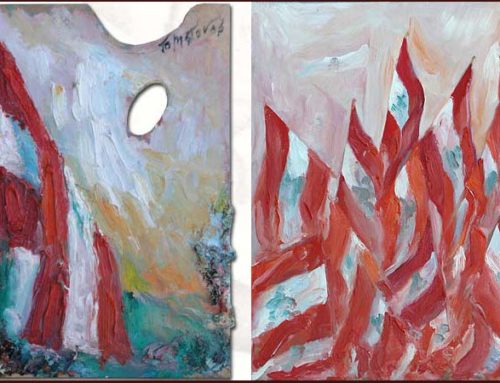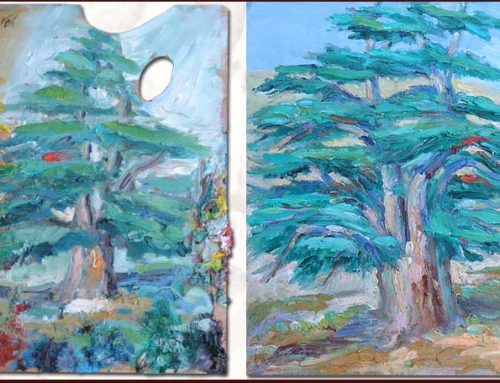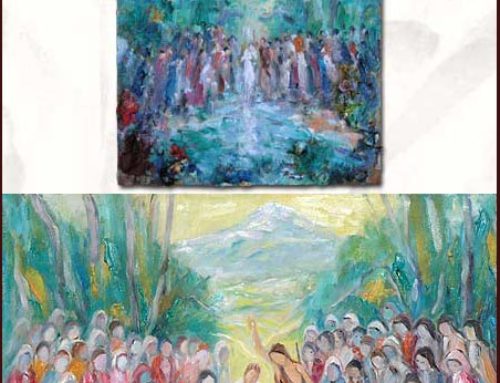A Story of Palettes
This happened some sixty years ago. It was the beginning of a story, a story of palettes. To start with, it was a piece of wood of varied shapes, a piece of lifeless plywood that was to evolve and become in due course and with age an essential part of my very soul and existence.
Let us go back over all that happened during the course of this evolution. I was just ten years old, more or less, and had a desire to use color, as I had seen in my books, using a wooden surface that is still called the palette ñ the name has not changed, only the forms, content, parts, symbols, play and so on. I found in the old lumber of our house in Jounieh the cover of a box ideal for my purpose, so I sketched on it an oval shape which I cut out with a saw. I also made a small space in which to insert my thumb. Around it, I placed powder of different colors and found a small holder for the oil and essence. This was my very first palette on which in an amateurish way I mixed my paints.
Was not a prehistoric man in his cave equally ingenuous? The important thing is the work and what counts is not the shape of the bottle but its content and the quality of the ensuing intoxication.
It was not only the palette that was homemade and particular. The brushes and all the beginnerís material were my own handiwork. I sawed out other palettes, more or less round or of longer or shorter oval form, until finally, I met professional artists when for the first time I found myself in real studios and academies.
George Corm told me that his father used a palette barely twice the size of the palm of his hand and so produced great works. Omar Onsi used an oblong palette but for a whim made a large palette that was almost a crescent, one with which he conceived divine proportions, finding there the keys to harmony when spreading it with his tints. Dozens of different palettes I tried before choosing the present rectangular form on which the colors are distributed, starting with the yellows and then the reds, blues, and finally the whites near the liquid recipient. I had dozens of these made at a carpenterís, for I often presented palettes to students like myself or to pupils.
Artist Rashid Wehbe, also Lebanese, always liked to scrub his palette and leave it clean, even if this meant losing the oils on its surface. For myself, as I was painting every day, I found it a pity to waste money and put new paints on this small surface of poetic play. The two edges, where there were clean tints freshly out of their tubes, I never touched. But the area where I mixed the colors was always cleaned up every time I finished work. As a result, the paints grew thicker round the edges and the palette became heavy in my hand until finally I was obliged to change the piece of wood which meant nothing to me and cost me nothing.
But the memories, nostalgia, events, and everything that came to my mind on seeing one palette or another created in me a feeling and an attachment for these inanimate objects which yet have a soul and reflect all that is deep within me. I soon felt that my palette was something profoundly intimate which lived beside me and with which I could hold dialogue, labor and rejoice, every one of my palettes being inseparable from my production. I felt that my blood circulated also in my palette and that the rhythm of my breathing, the air of my lungs, and the beating of my heart brought life to my palette, that my feelings, my love, my sensations, my ideas, and my communications should pass through my palette. This was another blank surface to be filled, one where I should venture and discover new worlds, the seasons in my heart, limitless distant horizons, the cosmos, and finally the love of God.
Each period of my life has its palettes and sometimes these bear the marks of certain major works of mine which have been particularly demanding of me.
There are the cruder palettes, the ones before I started my studies. Then there are the palettes from the time I was beginning, those of Spain, Madrid to be precise, then those of France, 1961, -63, -73, -75, -76, -92, 2001, the many that date from my travels to Paris, Cannes, Lyon, etc., the palettes of Kuwait and of Sao Paulo and Rio in Brazil, finally all those brought into being for my work in Lebanon ñ the palette too is a work which has its own dimensions.
As for the themes, they are many, and I give some examples: ñ The Annunciation, national motifs, the Baptism in Jordan, the nudes, the landscapes and houses, the triptychs, the flowers, the still-lifes, and compositions.
The palettes form a marvelous retrospective, as characteristic as the works of art themselves. From a mere lifeless object, the palette has been transformed into something brimming with life, with feeling, with love, from which I cannot be separated.
Joseph Matar
Translated from the French: K.J. Mortimer







